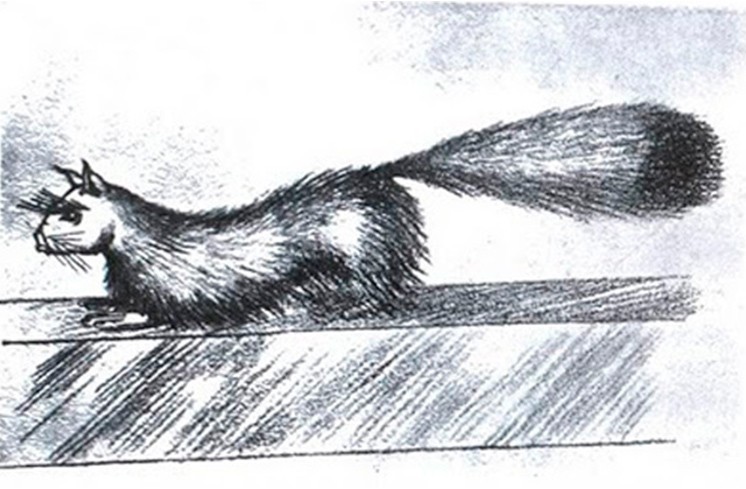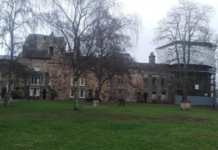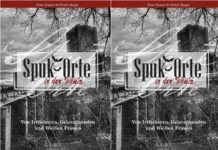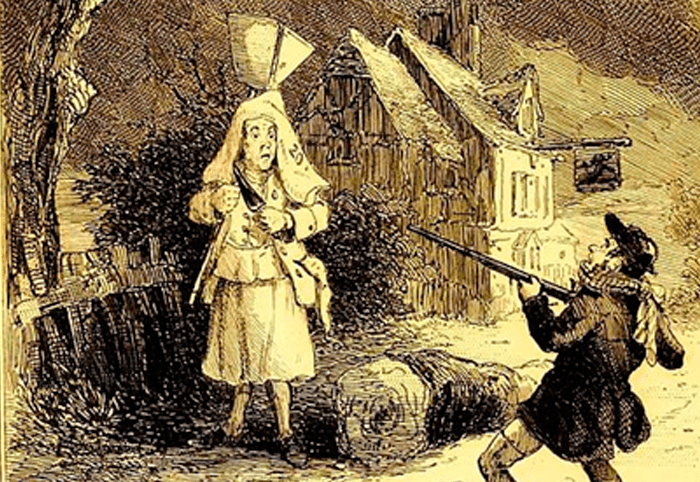Illustration of ‘Gef’ (1936) from the Haunting of Cashen’s Gap by Price and Lambert
GEF THE TALKING MONGOOSE
“You can think as you like,” said the monk, with a faint smile. “I exist in your imagination, and your imagination is part of nature, so I exist in nature.” Anton Chekhov, The Black Monk (1894).
The story of one of the weirdest poltergeist cases on record continues to run and run.
Ever since a special symposium was held at Senate House Library in London on April 10th 2014 – surely a candidate for the most unusual academic gathering of the year – the bizarre case of ‘Gef the Talking Mongoose’ (also known as the ‘Dalby Spook’) which occurred on the Isle of Man in the 1930s has become increasingly known and now boasts its own Facebook group.
The 2014 symposium was by Chris Josiffe and Dr Richard Epsley from Senate House Library, the audience heard papers offering a variety of perspectives on a story which is, by turns, whimsical, disturbing, utterly preposterous and yet strangely compelling. The day culminated in a special screening of a film Vanished! inspired by the tale, parts of which were recorded on location at Doarlish Cashen or Cashen’s Gap, the place where the mongoose first squeaked, whistled and chattered his way into public consciousness over eighty years ago.
Appropriately, Chris Josiffe who has been one of key players in rescuing this case from oblivion, opened the symposium with his paper, ‘On the trail of the Dalby Spook: an archival and anecdotal quest’. Being no mere armchair scholar, Chris Josiffe has made his own pilgrimage to the site of the isolated Manx farm where James Irving, his wife, and their teenage daughter Voirrey (Manx for Mary) spent years in communication with the talking mongoose which had taken residence with them. and went by the name ‘Gef’.
Gef was a lively, boastful and deceitful creature with a perverse sense of humour. He mysteriously appeared and disappeared at will, creating poltergeist-like disturbances, and speaking in a piercing, squeaky voice delivering a stream of eccentric chatter. According to the Irvings, Gef had his virtues, providing rabbits to supplement the family diet (they lived in extremely straightened circumstances). He was also a source of information and entertainment in their gloomy, oil-lit house, but at other times he appeared spiteful, malicious and threatening, like a demonic entity. As with alleged communications from so many psychic communicators, his talk was packed full of nonsense, lies, riddles and contradictions, yet on occasion he also relayed strikingly accurate information, displaying apparent gifts of clairvoyance and telepathy.
Although the Irvings dwelt on a remote hillside – a taxing 45 minute walk up a steep hill from Glen May village even today – their story became an international sensation. It attracted psychical researchers Harry Price and R.S. Lambert to the scene, along with many others, in the hope of encountering this extraordinary marvel, seemingly lifted from a 17th century witch’s confession of animal familiars. An extensive archive accumulated by researchers survives in Senate House Library, including correspondence from Irving, reports and what are claimed to be physical relics of Gef’s existence. Price and Lambert wrote a book on the case, The Haunting of Cashen’s Gap (1936) now very rare but available on line.
Gef’s utterances were meticulously logged by James Irving who openly shared them with anyone expressing interest. This helps explain why so much archive material exists and how Price and Lambert could produce a whole book on the case. In their The Haunting of Cashen’s Gap (1936) they dismissed Gef as “a voice and nothing else”.
Unfortunately, virtually the only witnesses to Gef’s speech and materialisations were the Irvings themselves. Whenever investigators and outsiders called, Gef was conspicuous by his absence; researchers experienced little more than whistles and other odd noises, and apparent stone-throwing. This suggested something strange was happening, but what?
Reports of peculiar animals appearing during poltergeist outbreaks were not unknown prior to Gef, an aspect raised in my own paper to the symposium; other cases have also featured talking spirits and even poltergeists called ‘Jeffery’ or ‘Old Jeffrey’. The most famous of these was ‘Jeffery’ the Wesley family poltergeist which manifested at Epworth Rectory in the winter of 1716-17 and where a mysterious badger-like creature was also seen. However, as Harry Price remarked in The Haunting of Cashen’s Gap differences between Jeffery and Gef are much greater than the resemblances. In the famous ‘Bell Witch of Tennessee’ case in 1817 a black dog was reported and the haunting of Willington Mill, Tyneside in 1835 also featured a strange creature, whi lst another black dog appeared in the Dagg Poltergeist outbreak in Canada in 1889. Frank Podmore, one of the few secptical writers to undertake any lengthy critique of poltergeist cases, recorded a case in 1894 where noises and object movements surrounded a young girl named Annie.
Voirrey Irving eventually produced some dubious evidence in the form of blurry photographs, and purported physical samples of hair and paw-prints (displayed at the symposium) but like so many material artefacts and fossils from anomaly research, they are scarcely convincing of anything, except perhaps a poorly executed hoax. But In passing, it struck me that in many ways the case of Gef is better documented than certain classic patient studies from medical and psychiatric literature (including some of the iconic cases of Freudian psychoanalysis). Yet the whole idea of a talking mongoose, either as a physical creature or a spirit entity, seems patently absurd.
Nonetheless, the Irvings continued to insist Gef was real, and never once retracted their stories. So was it a case of simple fraud, a shared mental delusion, or a genuine paranormal episode?
Given how we had all gathered to discuss him, it could certainly be said that Gef existed on one level, as a potent symbol and an example of the power of the imagination. One symposium speaker choosing to explore Gef and the power of the mythic imagination was Robin Klarzynski, in a paper, ‘Crossed Lines of the Dream Operators: a conversation concerning Gef, The Radiant Cat, and WS Burroughs’ Third Mind’. In this, he postulated connections between Gef and the literary and artistic theories of the novelist William Burroughs who was fascinated by the idea of cats as psychic familiars. Arguing that the talking mongoose story defied simple analysis, he suggested that all-or-nothing choices between Gef being exclusively either a psychic entity, a mental delusion or an out-and-out hoax were too fixed, and that that the boundaries between the inner world of the imagination and the external ‘objective’ world are far from fixed. Burroughs’ idea of a ‘third mind’ involving another layer of reality which materialises as a result of an amalgam of two or more minds or cultural sources might thus provide an aid to understanding Gef. Robin Klarzynski described experimenting with a collection of quotations ascribed to Gef and subjecting them to Burroughs cut-up technique of splicing texts, by submitting them to google translation multiple times. Such an approach made me think of random divination techniques, but no definitive insights have yet been yielded by the adoption of this unusual creative method.
In a paper from myself I considered the involvement of American researcher Nandor Fodor(1895-1964) at Cashen’s Gap. This occurred at a stage when Fodor was ceasing to believe in spirits, and becoming a convert to psychoanalysis, viewing poltergeists were projections from the Freudian subconscious.
Parallels between Gef and the ‘Bell Witch’ poltergeist in rural Tennessee in 1817 were drawn by Mark Bell (no relation) in his paper entitled, ‘Gef: A Modern Sphinx as an Esoteric Lesson about Oneness’. Some marked similarities appear in the ‘personalities’ of both entities and in their pretentious and rambling speeches. But whereas the voice of the Bell Witch (which actually claimed to be four separate entities) was heard by numerous witnesses, Gef was only heard to speak by the Irvings.
The question of an apparent clash between oral and literary cultures in the Irving household emerging from reactions to the utterances of Gef was explored in a fascinating paper by Dr Richard Espley ‘Reading the Mongoose, and the Mongoose Reading’. In this he conducted a detailed analysis of the written sources, suggests Gef manifested in a household which seemed rather hostile to books. This clash emerged when researchers such as Price and Lambert arrived from the mainland wanting to crystallize the claims and Gef’s talk in writing.
The two dominant speakers in the house at Doarlish Cashen were Gef and Irving, rather than his wife and Voirrey. Irving seems to have thrived on telling and re-telling the whole Gef story many times from the beginning. But what emerges from such re-tellings is not corroboration but rather the elevation of Irving in importance. In normal life, Irving was unsuccessful commercial traveller and farmer but after the arrival of Gef he became a minor celebrity, comparable to a court-holding figure from the bardic tradition, weaving fantastic sagas for his listeners and achieving status for himself via Gef. In reality, Price and Lambert seem to have found listening to Irving rather tedious, and their literary treatment of Gef diminished Irving’s significance in the story. This paper raised an obvious question, was Gef simply a mouthpiece for Irving?
However, Gef’s story, along with other Manx supernatural traditions were a major influence upon science fiction and horror writer Nigel Kneale, born on the island in 1922. In his paper ‘Gef on Television? Nigel Kneale’s Beasts and the Desacralization of Modernity’ Craig Wallace traced how the themes of witchcraft and poltergeists drifted through Kneale’s writing over many decades. References to poltergeists and teenagers could be found in his short stories as early as 1949, and historic poltergeist hauntings and the appearances of imps and demons provided a framing device for the discovery of a Martian spaceship in his classic Quatermass and the Pit (1959). Most notably, supernatural and freakish animals featured in each of Kneale’s plays that comprised the 1970s TV series Beasts. One episode in particular, ‘Special Offer’, featured an animal poltergeist wreaking havoc in a supermarket; indeed I recall seeing a prelude to its transmission by Anglia TV in October 1976, in which Kneale expressly mentioned the ‘nine day wonder’ of a talking mongoose on the Isle of Man ‘many years ago’; maybe this broadcast fragment survives somewhere?
Completing the day was the film of Vanished! a dramatic re-telling of the Talking Mongoose story, introduced by the writers Brian Catling and Tony Grisoni. They detailed their extensive research behind the making of the film, and their attempts to contact Voirrey Irving. She refused to co-operate but they did succeed in interviewing another elderly lady from the island who recalled a visit to Cashen’s Cap and who suggested noises were being staged by Mrs Irving.
Vanished! is certainly an eerie piece of film making, beginning with the sound of the winds over the desolate hills, recorded at the site of the Irving’s home. Wisely the film avoids showing Gef speak directly, but relays the details through the powerful conceit of summoning back the spirits of the Irvings to a séance at their old house, in order to tell their stories, each giving their individual version of events. Irving is keen to justify himself and declare the importance of Gef to the world, whilst the two women begrudge being summonsed back, and recall Gef with many regrets and negative feelings. Via their fictional treatment Catling and Grisoni have, at least in art, restored some semblance of balance to the recital of the tale in letting the voices of the female characters in this weirdest of domestic dramas be heard.
Of course, short of summoning back the dead, we are never likely now to know the ultimate truth about Gef and the Irvings, but certainly interest in the talking mongoose and poltergeists in general is set to continue. Practically every week a new report of a poltergeist outbreak reaches the Society for Psychical Research from somewhere in the world – but will there ever be another Gef? Voirrey died 2005 but research into the case continues and Chris Josiffe is working on a book which will hopefully be published later this year.




